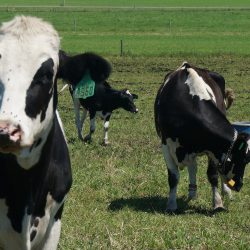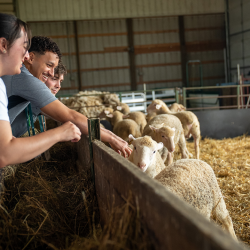Over Spring Break, five MSU veterinary students traveled to White Mountain Apache Reservation
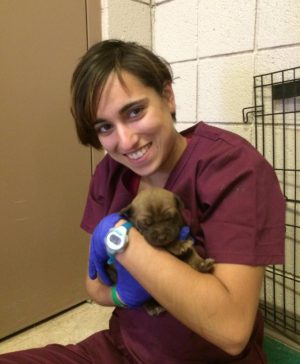
By Elaine Sheikh ('18)
I’m in my second year of the DVM program, and still a year away from clinics and “real live” animals. A few months ago, I realized that all this time in my books had made me feel a little stagnant in my studies.
I heard from my classmate Chloe Apelgren about a service opportunity through the Humane Society Veterinary Medical Association (HSVMA). She took a trip last year with the HSVMA Rural Area Veterinary Services (RAVS) program, which gives veterinary students the chance to get out in the field to bring free veterinary services to underserved rural communities.
A week out in the middle of nowhere, helping animals and their families? Sign me up! I sent in my application, submitted a background check, and raised funds, thanks to the generosity of friends. My birthday present from my mom was extra scrubs for the trip, and my dad provided a cash gift to help me with airfare. In just a few months, my dream became a reality.
Take-off
At 6:00 p.m. on March 12, the Saturday before Spring Break, I met up with four fellow students at the Detroit airport. Judy Duderstadt is a third-year veterinary student with years of experience as a veterinary assistant. Jen Travers, former attorney, is a second year, like myself. Kira Ellsasser and Natalie Gugulana are first-year students.
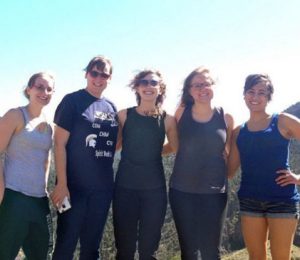
All of us are members of the Shelter Medicine Club and were excited to get out into the community and put our skills to use, helping educate clients and change the world, one vaccine or spay/neuter at a time. Judy had been on a two-week RAVS trip, but for the rest of us, it would be our first time. Kira had been on other veterinary service trips, and I have a lot of experience working in shelters, but we weren’t really sure what to expect. Boy, would we learn fast!
We arrived in Phoenix late Saturday night (or early Sunday morning, depending on how you want to look at it). At 9:00 a.m. on Sunday morning, we met up with the rest of the RAVS volunteers and staff members and caravanned 200 miles on a winding road through the mountains and Salt River Canyon to the White Mountain Apache Reservation, where we would spend the next week. Our team consisted of 18 veterinary students, 8 volunteer veterinarians, several veterinary technicians, and the veterinarians and technicians on staff.
Our supplies and the RAVS team were amazingly organized. In just a few hours, a high school wrestling practice room was converted into a six-table operating room, recovery suite, and induction area with a special tent so cats could recover separately from dogs. We had an orientation and took a practical test to show our surgical competency (either a Surgeon’s or Miller’s ligation in less than 30 seconds, and a closure of our choice in less than three minutes). Then we set up our sleeping space on the floor of the boy’s locker room. We were to report to one of three stations: receiving, anesthesia, or surgery, at 6:00 a.m.
New Challenges
I admit I was shocked at some of the conditions we saw animals in. There was an incredible amount of mange, tickborne diseases were rampant, and everyone either had lost a puppy to parvovirus or knew someone who had.
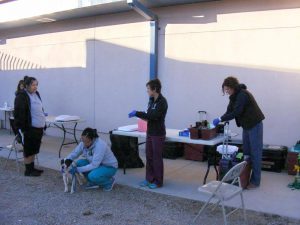
We saw several cases of transmissible venereal tumors (TVT) and acute cases of canine distemper virus, which is something that is rarely seen in most areas of the country, where herd immunity is high. Most families owned several dogs and cats, and there were feral dogs roaming about.
It struck me that there was a real absence of education on pet care and disease prevention. We talked to families about the importance of spays/neuters to not only prevent unwanted puppies, but to prevent the spread of TVT. We also explained how to try to disinfect facilities from parvovirus and spoke about the importance of vaccinations.
Nutrition was a topic that was difficult to approach because of access to pet food and cultural habits. But we provided information on food, particularly feeding sick and pregnant or nursing dogs. It was hard to see so many animals in rough shape, but we were able to treat the sick animals, and had the opportunity to provide education to owners that would help them keep their animals healthy.
Understanding Culture and Expanding Horizons
There are several factors that affect the care of animals. A lot of people, especially the younger tribe members, view their animals as pets, but the sense of ownership is just very different. Especially for older people, there isn’t always a clear distinction between pets that are “owned” and animals that roam about and just do as they please. As I was helping one man with his mom’s two dogs, he explained to me that a lot of the older tribe members view animals with superstition. His mother believes that if a dog watches you eat, they themselves become full. She wouldn’t let dogs near her kitchen or human food. He told me that he buys big bags of dog food and throws them down in a dry river bed to feed the feral dogs, hoping to prevent them from raiding people’s yards.
I feel that we need to work to educate people while respecting cultural differences. I would love to see a trip where we hold clinics specifically geared towards learning from the community and then teaching them how to care for animals in their own way, while promoting optimal animal welfare at the same time.
Work on Spring Break: Worth it
We left the reservation on March 30 around 4:00 p.m. I think I speak for everyone on the trip when I say that we left exhausted, but inspired by what we were able to accomplish.
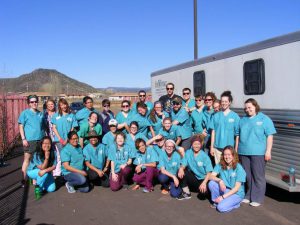
It takes a really special group of people to come together on their limited time off work or school to work from before sunup to long after sundown in a new place with no cell phone service, unpredictable food, no guarantee of showers, and a lot of animals who aren’t used to being handled. We had a phenomenal group of volunteers, and I was honored to work alongside them.
If you are interested in community service, shelter medicine, or just stepping outside of your comfort zone, I encourage you to apply for a trip, raise the money required, save up to buy you plane ticket, and go do your little part to help change our world! Even though it may seem like your ability to make an impact is small, the life of every single dog and cat who receives care is changed for the better. Even if you don’t see a world-wide change, the world of each individual animal you touch can be changed. Just do it!
About the author: Elaine Sheikh is a second-year veterinary student who started school with the intention of being an equine sports practitioner. Her focus currently is on a board certification in diagnostic imaging, with anesthesia being a close second interest. Her dream is to open an equine specialty clinic and make enough money to work four days a week so she can volunteer her services in a shelter one day a week.

